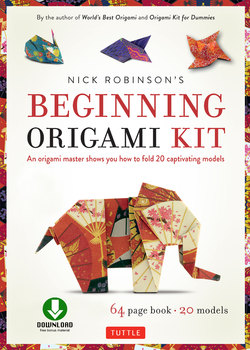Читать книгу Nick Robinson's Beginning Origami Kit Ebook - Nick Robinson - Страница 7
На сайте Литреса книга снята с продажи.
ОглавлениеHow to Fold
Folding paper neatly and accurately isn’t always easy for newcomers to origami. However, there’s no good reason why you can’t improve, no matter how little confidence you have. Here are a few simple tips:
Fold slowly; it’s not a race. You will get much better results.
Fold the paper away from you rather than toward you (where you hands can get in the way).
Set aside plenty of time to fold; it’s not good for your concentration if you have distractions.
Fold at a well-lit table, with enough space for your elbows.
Make all creases sharp to begin with, making sure the paper is perfectly positioned before flattening.
Make each model at least three times using cheaper paper before using your best paper.
Cut the paper very accurately if you make your own squares from a larger sheet. A rotary trimmer is a good investment.
Fold in a small group. It’s fun and will also teach you a lot in a short time.
Teach the model to other people. It will really help your understanding of the folding sequence.
Choosing Paper
Origami usually requires paper that is perfectly square. When you have used all the sheets in this kit you’ll need to source your own paper. There are lots of options for “proper” origami paper (which can be bought cheaply on the Internet), but you can also choose from many other types of paper, especially if you want to fold a large version of a model. The paper should be crisp and capable of “remembering” a crease (so it doesn’t try to unfold itself). Craft and art shops have a huge range of beautiful papers. Try to choose a pattern that really suits the final design. It’s a better value to buy a large sheet and then cut it down to make several smaller squares.
Here is a simple method for creating a square from a rectangle:
Fold a short edge to a long edge.
Fold the surplus paper over the edge, crease and unfold.
Unfold the paper fully.
Cut off the surplus paper to leave a square.
